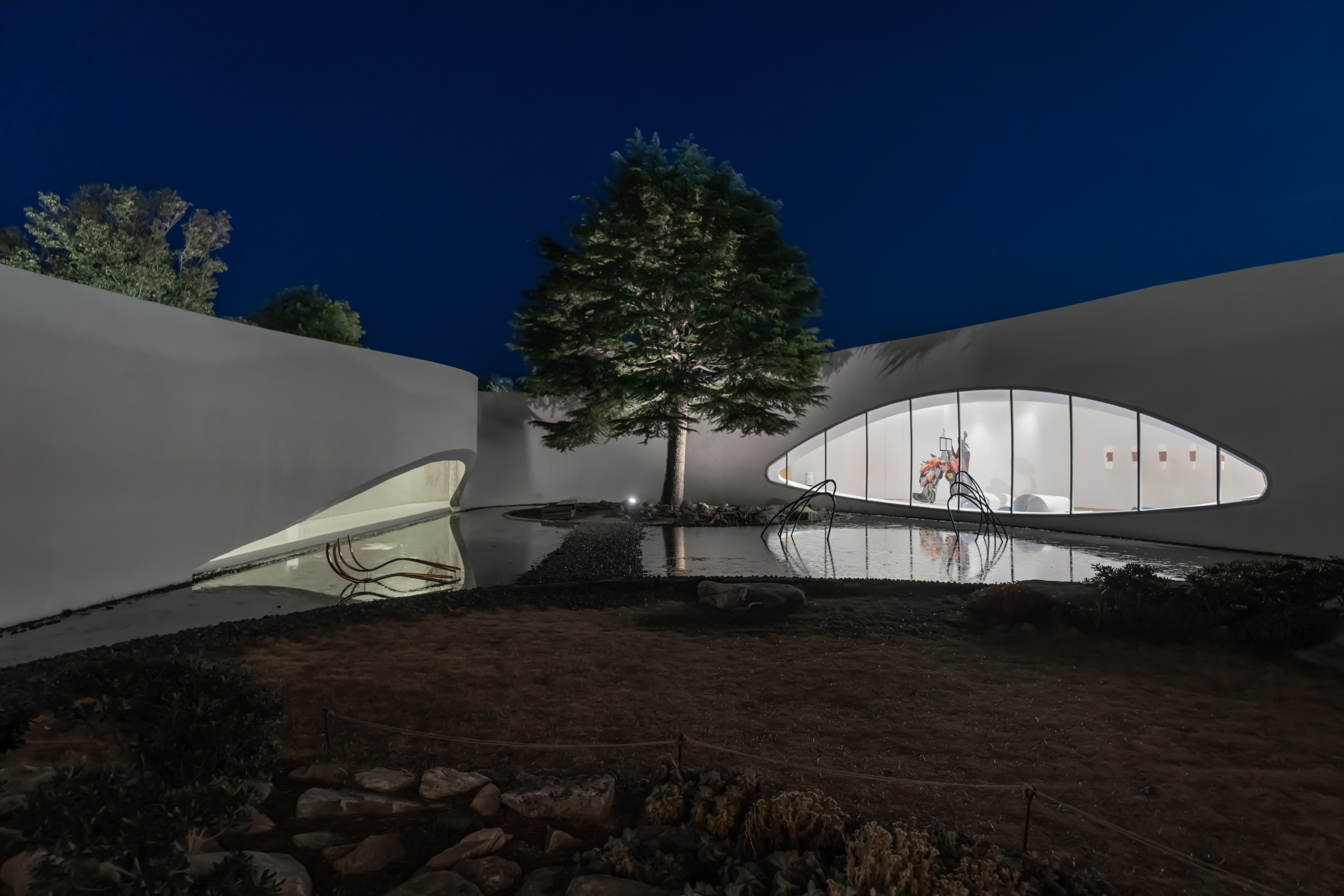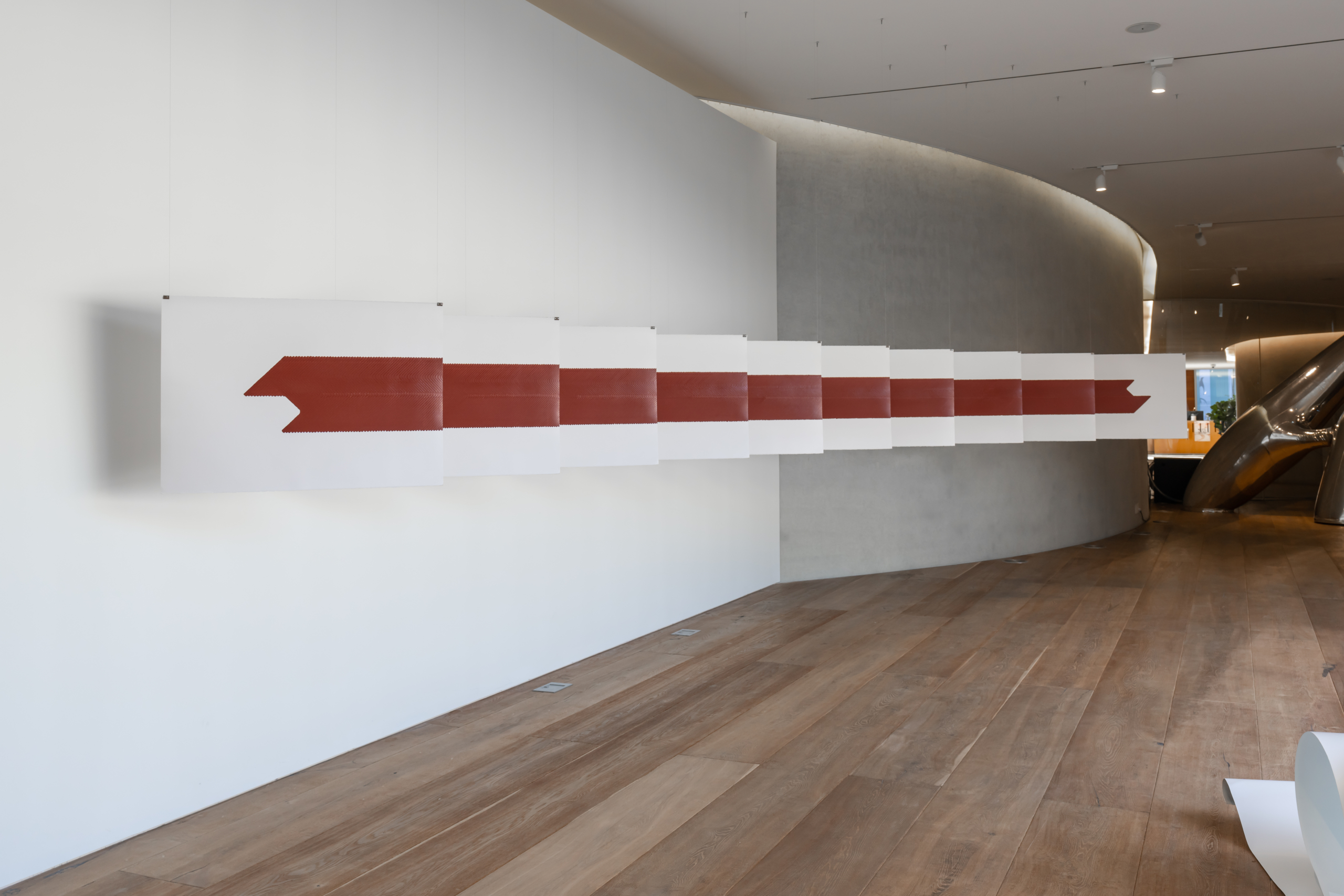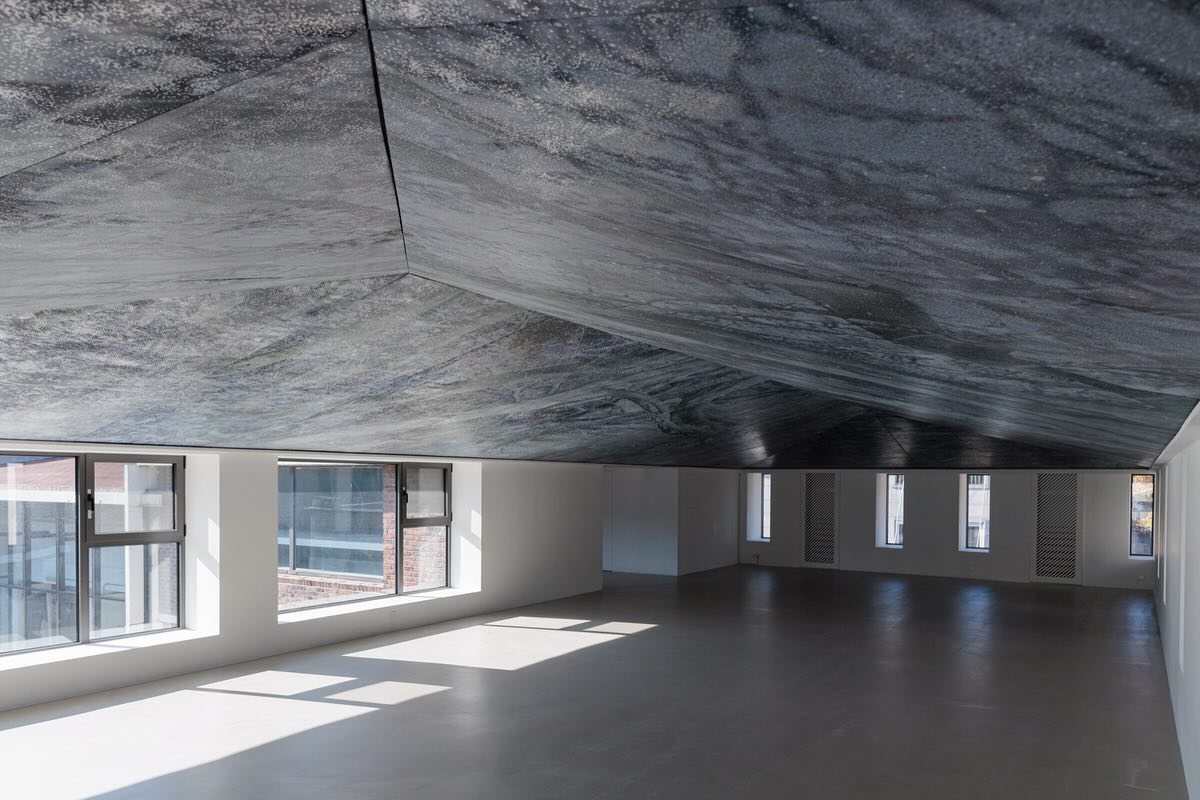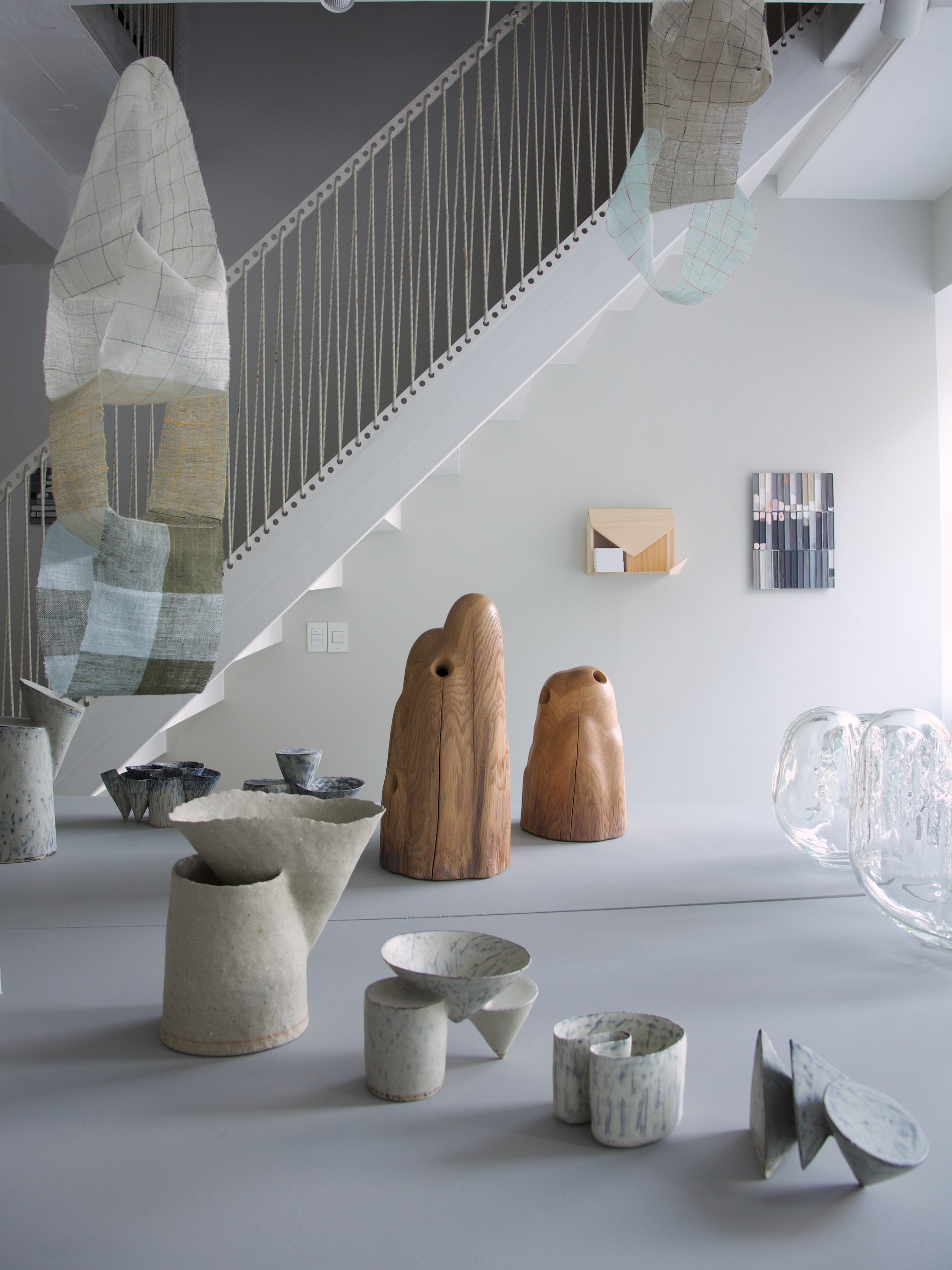Park Taejoon Memorial Hall’s Metal Fluid exhibition presents works by Sun Mee Kang, Jaewon Kang, Osang Gwon, Kim Donghae, Byun Sanghwan, Soyoung Chung, and Choi Goen, who have achieved national recognition through their sculptural works, until March 12.
 Poster image of "Metal Fluid" at the Park Taejoon Memorial Hall, Busan. Courtesy of the memorial hall.
Poster image of "Metal Fluid" at the Park Taejoon Memorial Hall, Busan. Courtesy of the memorial hall.Amidst the growing understanding of experiencing space and appreciating architecture, the Park Taejoon Memorial Hall in Gijang-gun, Busan, was opened in December of 2021 with a space that emphasizes light and curves through a steel structure.
Honoring the late Park Taejoon, the King of Steel and founder of POSCO, the largest steel company in Korea, the exhibition space was established to support young artists through exhibitions, performances, and education programs.
The memorial hall deals not only with the biography of the honorary chairman Park Taejoon but also with the history of steel in Korea, from the discovery of iron ore to the exploration of metallicity and modern society’s metal consumption.
 Courtyard view of the Park Taejoon Memorial Hall, Busan. Courtesy of the memorial hall.
Courtyard view of the Park Taejoon Memorial Hall, Busan. Courtesy of the memorial hall.The Park Taejoon Memorial Hall, which celebrated its first anniversary on December 20, 2022, invited Space So’s curator Heejung Song to curate an exhibition that responds to the memorial hall’s mission and purpose.
Through March 12, Metal Fluid presents sculptural works by Sun Mee Kang, Jaewon Kang, Osang Gwon, Kim Donghae, Byun Sanghwan, Soyoung Chung, and Choi Goen. The seven participating Korean artists, who were born between the 1970s and 1980s, are mid-career artists who have created an independent body of work with national recognition.
 Exterior view of the Park Taejoon Memorial Hall, Busan. Courtesy of the memorial hall.
Exterior view of the Park Taejoon Memorial Hall, Busan. Courtesy of the memorial hall.Although metal is the theme of this exhibition, the show does not simply focus on the physical properties of the solid mass. Instead, the exhibition examines the various characteristics of metal—such as iron’s unique luster, malleability, and ductility when elongated—from various angles and adds new interpretations to works that harmonize with architecture.
 Installation view of Sun Mee Kang's artworks in "Metal Fluid" at the Park Taejoon Memorial Hall, Busan. (December 20, 2022 – March 12, 2023). Courtesy of the artist and the memorial hall.
Installation view of Sun Mee Kang's artworks in "Metal Fluid" at the Park Taejoon Memorial Hall, Busan. (December 20, 2022 – March 12, 2023). Courtesy of the artist and the memorial hall.Sun Mee Kang (b. 1977) embodies her experience of space or the complex phenomena occurring in modern society through geometric pattern drawings, particularly using fine line tapes or adhesive sheets on the wall. Kang breaks away from conventional art materials and creates works that will disappear when the exhibition is over. Through her works, the artist aims to discuss the validity of time and metaphorically express various issues in modern society or individual life.
Kang’s artworks presented in this exhibition were created with the motif of the unique pattern of iron ore, the raw material of iron. The works on the rotunda wall of the building represent the accumulated time and the consequent result of continual endeavors.
 Installation view of Jaewon Kang's artworks in "Metal Fluid" at the Park Taejoon Memorial Hall, Busan. (December 20, 2022 – March 12, 2023). Courtesy of the artist and the memorial hall.
Installation view of Jaewon Kang's artworks in "Metal Fluid" at the Park Taejoon Memorial Hall, Busan. (December 20, 2022 – March 12, 2023). Courtesy of the artist and the memorial hall.Jaewon Kang (b. 1989) creates digital sculptures based on 3-D modeling programs. In the virtual space, Kang implements the environment in which the sculptures are placed and searches for the physical properties of the sculptures by rendering lighting. In the digital space, Kang can easily move the sculpture, restore its previous form, and create duplications with a single click. On the other hand, his sculptures, realized in the real world, look much like heavy metal but are actually made of lightweight materials such as inflatables.
Kang continues to imagine the future sculpture by deliberately discarding the conventional notion of the genre. Traditional sculptures have certain characteristics due to their volume and weight and require viewers to move around them to appreciate the work, but Kang overturns these sculptural characteristics. Kang’s artworks emit a metallic texture and unique luster or mimic the real sculpture within a digital space.
 Installation view of Osang Gwon's artwork in "Metal Fluid" at the Park Taejoon Memorial Hall, Busan. (December 20, 2022 – March 12, 2023). Courtesy of the artist and the memorial hall.
Installation view of Osang Gwon's artwork in "Metal Fluid" at the Park Taejoon Memorial Hall, Busan. (December 20, 2022 – March 12, 2023). Courtesy of the artist and the memorial hall.Osang Gwon (b. 1974) experiments in various angles with the characteristics of sculpture, such as its three-dimensionality, weight, and volume. Gwon takes hundreds of photos of a subject to recreate them into sculpture works, or cuts out advertisement images and puts them up as standing boards for photographic works. These cutouts are sometimes enlarged with computer software, making them into large-scale standing works.
Gwon’s New Structure series, a study of Alexander Calder’s Stabile, is presented in the exhibition. Using images collected from advertisements, the artist created the series to emphasize the flatness of the standing structures made with large metal plates. The series attempts to blur the boundaries between flat and solid and to look back at the work of the master sculptors from a new perspective.
 Installation view of Kim Donghae's artworks in "Metal Fluid" at the Park Taejoon Memorial Hall, Busan. (December 20, 2022 – March 12, 2023). Courtesy of the artist and the memorial hall.
Installation view of Kim Donghae's artworks in "Metal Fluid" at the Park Taejoon Memorial Hall, Busan. (December 20, 2022 – March 12, 2023). Courtesy of the artist and the memorial hall.Kim Donghae (b. 1987), who majored in metal crafts, creates objects in the form of plants inspired by natural landscapes that are easily encountered in our daily life. Cold and hard metal is given an organic form and structure through the artist’s touch. The artist explores the formative characteristics of plants to build a geometric yet relational structure in which metal wires and plates are connected. The artist does not simply transfer metal into the shape of floras but captures the beauty that can be found in the plant’s physiological characteristics, such as its movement and growth environment.
Kim’s artworks in the exhibition visually present the relationships between materials, objects, people, and time and space, embracing various connections such as metal, plants, nature, environment, and spectators.
 Installation view of Byun Sanghwan's artwork in "Metal Fluid" at the Park Taejoon Memorial Hall, Busan. (December 20, 2022 – March 12, 2023). Courtesy of the artist and the memorial hall.
Installation view of Byun Sanghwan's artwork in "Metal Fluid" at the Park Taejoon Memorial Hall, Busan. (December 20, 2022 – March 12, 2023). Courtesy of the artist and the memorial hall.Byun Sanghwan (b. 1986) works on sculptures but also includes painting, printmaking, and performance in his artworks. Byun captures mundane objects, such as old or familiar things, that he encounters in the daily urban landscapes of Korea. By emphasizing the presence of these objects and revealing their space, the artist seeks to overturn the information we take for granted.
Byun’s Live Rust-만자왕(King of Swastika) is a group of works made by printing several sheets of reddish-brown steel sections coated with anti-rust paint. Each sheet of prints that has irregularities created by the paint is hung at regular intervals, creating a geometric pattern that seems to gradually dominate the exhibition space.
 Installation view of Soyoung Chung's artwork in "Metal Fluid" at the Park Taejoon Memorial Hall, Busan. (December 20, 2022 – March 12, 2023). Courtesy of the artist and the memorial hall.
Installation view of Soyoung Chung's artwork in "Metal Fluid" at the Park Taejoon Memorial Hall, Busan. (December 20, 2022 – March 12, 2023). Courtesy of the artist and the memorial hall.Soyoung Chung (b. 1979) examines our society to discover hidden stories and read their values through her installation works. Chung’s site-specific installations, sculptures, and video works are carried out through geological surveys and urban studies. Through this process, the artist shows the relationships and changes created by human society within nature. In particular, the artist sees the erosion and sedimentation of the land as a clue to understanding human history. Her works link research results with imagination to experiment with the flexibility of material and sculpture, as well as to ask questions about the dichotomies of material and non-material, artificial and natural, and past and future.
In the exhibition, Chung’s metal plate works— which look like thick rubber bands or running-down fabrics— are presented, showing a certain flexible elasticity through the hardness of iron. Another of her exhibited works was formerly installed at an evacuated US military camp in Wonju, Gangwon-do. The work depicts modern history that rolls between the Korea-US alliance and civilian welfare. Another artwork imagines outer space where time and space are curved.
 Installation view of Choi Goen's artworks in "Metal Fluid" at the Park Taejoon Memorial Hall, Busan. (December 20, 2022 – March 12, 2023). Courtesy of the artist and the memorial hall.
Installation view of Choi Goen's artworks in "Metal Fluid" at the Park Taejoon Memorial Hall, Busan. (December 20, 2022 – March 12, 2023). Courtesy of the artist and the memorial hall.Choi Goen (b.1985) deletes the original social and cultural functions of everyday objects by placing household appliances, such as refrigerators, rice cookers, and air conditioners, or industrial materials on pedestals to emphasize their pure aesthetics. Choi evokes the meaning of existence by severing the relationship between objects subordinated to the capitalist market.
Choi’s artworks presented in this exhibition are sculptural works made of stainless steel and copper pipes for water supply facilities. The long pipes creating dramatic curves highlight the forms of the objects that are usually hidden inside the floor or wall of a building, expressing the artist’s own interpretation of our society.












